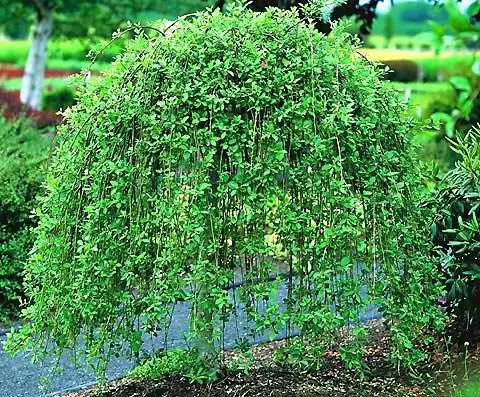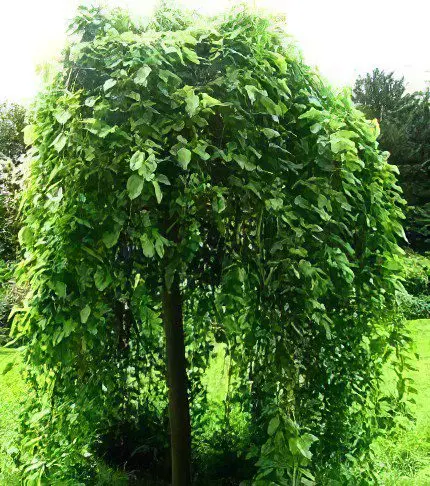Contents
Useful properties and application of goat willow
Botanical characteristics of goat willow

goat willow belongs to the willow family, it can be called a shrub or tree. In young plants, the bark of the trunk is greenish-gray in color, as it grows older, it acquires a brown surface with cracks. Young shoots show pubescence and large buds. The plant has leaves of different shapes and sizes. They are ovoid, round, elliptical. In any part of the branches, you can see oblong-lanceolate, wavy, serrated leaves.
The leaves also differ in surface: they can be dense, wrinkled, bare on top, dark green, with a felt gray bottom plate. Goat willow blooms before leaves appear on it, with yellowish-gray flowers collected in drooping inflorescences – brushes like earrings. In the fruit-box are wavy gray seeds. For growth, goat willow chooses streams, glades in forests, loves the neighborhood of various shrubs. The parts of the plant used for treatment – bark, leaves, flowers – are collected at different times.
Useful properties of goat willow
Goat willow bark contains a large amount of tannins, alkaloids, flavonoids, phenol glycosides. These substances are also found in the leaves, but in a smaller composition. Flowers and leaves contain vitamins, saponins, organic acids, lipids. The presence of nitrogen-containing compounds, proanthocyanidins, catechins and essential oils was recorded.
The acid hydrolyzate endowed with willow consists of lauric, myristic, pentadecanoic, margaric, arachidic, and heneicosanoic acids. Decoctions and infusions of goat willow have a hemostatic, astringent, anti-inflammatory and antiseptic effect. The plant is valued for its wound healing and tonic properties.
The use of goat willow
A decoction of willow bark is used for rheumatism, whooping cough, fever. Medicinal drugs successfully treat headaches and neuralgia, are recommended for gout, various bleeding, gastrointestinal diseases, malaria. Goat willow acts as an anthelmintic. Externally, the plant is used for gargling. Lotions with decoctions relieve skin inflammation in dermatitis. Raw materials in powder form help against ulcers, wounds, boils, and are used as a powder.
Goat willow is also an effective remedy for excessive sweating. In this case, you can make local baths for the armpits and take the decoction inside, as a result, the work of the sweat glands is normalized.
In Asia, willow in the form of decoctions and infusions is used to reduce the temperature in case of colds and infectious diseases. The sedative effect of plant substances affects the quality treatment of the cardiovascular system, tachycardia. The diuretic properties of willow relieve edema of various origins, decoctions are recommended for hypertension and kidney disease.
Goat willow bark
In many countries, goat willow replaces quinine and aspirin, which was derived from this medicinal plant. The bark is brewed as a tea for sweating during flu and acute acute respiratory infections. It has a general strengthening effect. For people with a number of diseases, goat willow bark becomes a natural medicine that promotes a quick recovery. It is recommended to take funds from willow bark as a preventive measure. The raw material contains useful substances that allow you to keep the weight on the results achieved in the treatment of obesity.
Healing tea can be drunk for three to four weeks, the course should be carried out once every six months. A decoction of goat willow bark is used to treat gastrointestinal and peptic ulcers, neuropsychiatric disorders, varicose veins, thrombophlebitis. Rinsing with a decoction or infusion heals bleeding gums. taking funds inside removes inflammatory processes in the liver, cures tuberculosis. The bark helps with the weakening of visual acuity and hearing.
Willow bark decoction: 20 g of the bark is crushed, poured into 200 ml of boiling water, cooked in a water bath for 30 minutes, cooled for 10-15 minutes, filtered. You need to drink the medicine 2 tablespoons 3-4 times a day.
A decoction of willow inflorescences: 10 g of willow inflorescences are poured into 200 ml of boiling water, put in a boiling water bath for 15 minutes, cooled for 45 minutes, filtered. Daily take 2 tablespoons 3-4 times a day until recovery.
Goat willow planting
Goat willow is an ornamental shrub, its weeping shoots at the top of the trunk form a tent. The plant is light and moisture-loving, it requires a well-lit place for planting. Goat willow is propagated by grafting. The tree requires special pruning, especially in the first years after planting. A plant without proper care cannot develop normally. Pruning must be done after flowering (in June).
In order for the crown to form correctly, it is necessary to cut off the young shoots, leaving the buds with their tops up and to the side, then the crown will grow in the form of an umbrella. Willow reproduces well by seeds, cuttings practically do not take root.
Ivy goat “Pendula”

A wonderful variety of goat willow “Pendula” has a weeping crown with falling branches; during the flowering period, numerous incredibly beautiful decorative golden-yellow earrings are formed that appear long before the foliage blooms. The plant has stiff brown-red shoots that grow slowly upwards and quickly grow in length. Elliptical matte green leaves are covered with pubescence from the inside. Willow “Pendula” is resistant to frost.
This variety grows well on any soil, demanding only on irrigation conditions. Willow is an excellent honey plant, its fluffy flowers are unusually attractive to insects with a large amount of nectar.
Weeping goat willow
Weeping goat willow in nature grows on the banks of ponds, near streams, chooses river lowlands for habitat, prefers moist soils. Inconspicuous at first glance, the plant is loved by goats. A standard male form of the plant is planted in the plots, which reaches a height of 1,8–2,5 (sometimes 3) m. The crown has weeping branches hanging to the ground, the bark is greenish-gray, smooth, covered with cracks at the base, the shoots are greenish in color.
Weeping willow has oblong elliptical leaves. In April, but not every year, fragrant, golden-yellow inflorescences-earrings appear. The plant develops very quickly, frost-resistant.
Iva Goat Kilmarnock
A magnificent ornamental tree will become a real decoration of any garden, its small weeping crown, shoots hanging to the ground and charming catkin flowers will make any landscape expressive. The crown of an adult shrub is 1,5 m in diameter. The plant blooms for up to two weeks, loves open sunny areas, but also tolerates slight darkening well. Willow nectar gives bee honey an excellent bitter taste. honey has a healing effect on various colds, it can be used by patients with diabetes.
Willow goat globular
Willow goat spherical – a low dwarf form, the special piquancy of which lies in the spherical crown with unusually graceful shoots directed down.
Leaves are lanceolate, leathery. The underside of the leaves is grayish-white-felt, the upper side is dark green, leathery. The flowering period of willow spherical begins long before the appearance of leaves and lasts 20 days. Fluffy yellow earrings attract the attention of people and beckon insects with nectar. Willow of this species grows quickly, tolerates frost and drought well. An ornamental plant adorns alleys and lawns.
Contraindications to the use of goat willow
The use of goat willow is contraindicated in gastritis with high acidity, uncontrolled use of decoctions can provoke constipation. Goat willow should not be used if low blood clotting is diagnosed and in case of individual intolerance.









